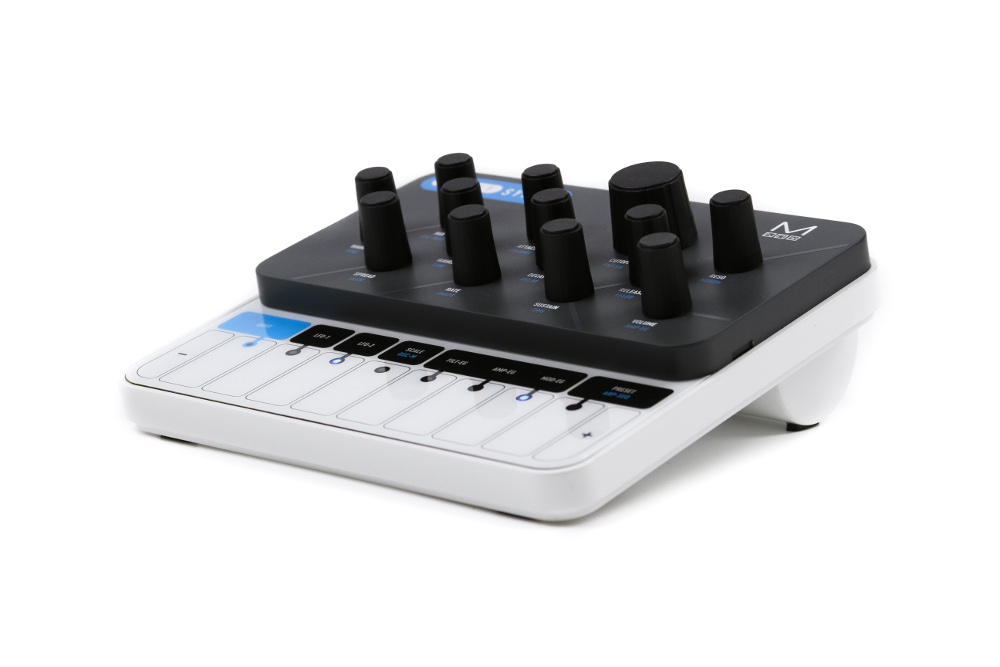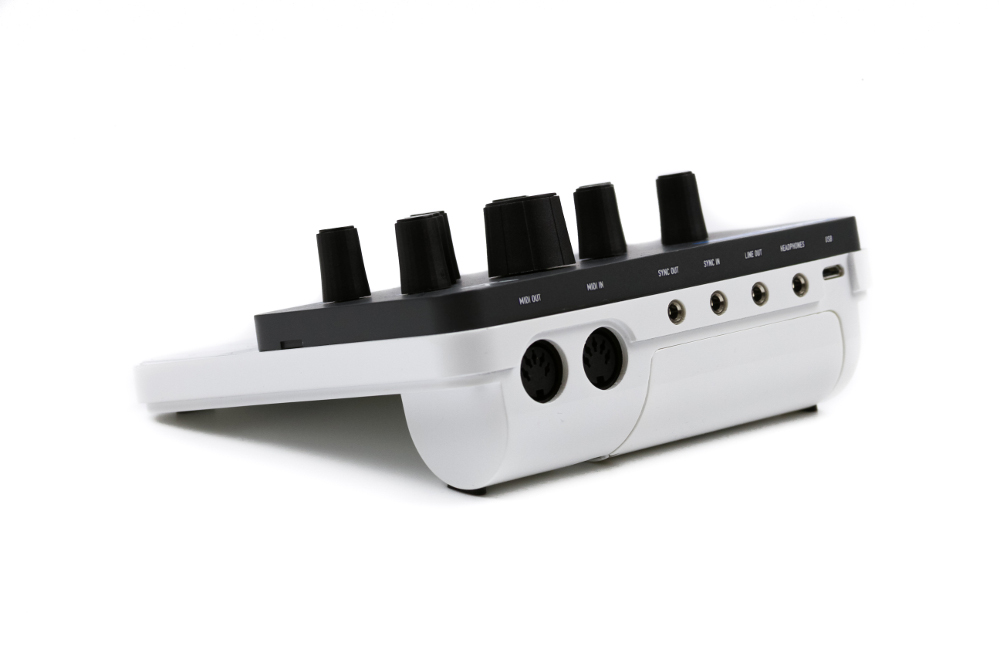Kickstarter for Modal CRAFTsynth v2.0 Monophonic Wavetable Synth to End on January 9th
There’s a sequel on the way to the micro-but-mighty CRAFTsynth from Modal Electronics: Modal CRAFTsynth 2.0.
Those who want to get in early on this powerful new synth have one week left, by backing the company’s Kickstarter campaign which wraps January 9th.
Modal CRAFTsynth 2.0 will continue the tradition of raw synth power from the original CRAFTsynth, while adding many new features, as well as the expectations from compact, portable battery powered synthesiser.
Reflecting the design ethos of the recently released Modal SKULPTsynthesiser, CRAFTsynth 2.0 provides sonic versatility and sound design capabilities in a completely portable package.

CRAFTsynth 2.0 retains many of the core features of the original including:
– 8 oscillators per voice
– 2 selectable waveforms
– Morphable state variable filter
– Multi-option unison / spread
– Waveshaping distortion
– Touch pad scales
Now, the new features of CRAFTsynth 2.0 include:
– 40 (8 banks of 5) morphable waveforms (v1.0 had 5 non-morphable waveforms)
– Improved filter with panel control for morphing between filter shapes
– 2 LFOs (v1.0 had 1 LFO)
– Assignable modulation envelope
– Full control of the Amplitude and Filter envelopes from the panel
– 8 modulation sources with 1 destination per source (v1.0 had limited modulation routings for 1 LFO and Mod Wheel only)
– Improved Delay FX with modulatable delay time
– A sequenced arpeggiator
– 8 slots for playable scales on the touch keyboard, where 7 can be configured from an extensive list of preset scales and 1 can be set as a user-configurable scale configured using MODALapp (v1.0 had 5 preset scales)
– 64 patch memory (v1.0 had a 16 patch memory)
– MIDI-DIN IO ports
– Analogue clock sync IO ports
– 12 rotary encoders (v1.0 had 8 potentiometers)
– 16 touch pads, with 8 used as a touch keyboard (v1.0 had 5 touch pads)
– 8 LEDs for displaying parameter values (v1.0 had 4 LEDs)
– Built-in battery pack (v1.0 battery pack sold separately)
– Delivered as a pre-built device with an enclosure (v1.0 was a DIY device with no enclosure)
Modal CRAFTsynth 2.0 measures a compact 150 x 135 x 68mm (6”x5 1/2”x 3”) and weighs around 300g (less than 1lb) and can be powered by either 3 x AA batteries or USB.

The Kickstarter campaign for the Modal CRAFTsynth v2.0 Monophonic Wavetable Synthesiser concludes January 9th, 2019.
Besides power, USB connectivity also provides CRAFTSynth 2.0 with a Class Compliant USB MIDI connection, enabling CRAFTsynth 2.0 to play in an integrated setup with MacOSX, Windows or iOS & Android tablets and phones.
The MODALapp editor provides complete visual access and control to all of the features of CRAFTsynth 2.0, along with tight integration of Modal’s first generation CRAFT devices (CRAFTsynth 1.0 and CRAFTrhythm), as well as the Modal SKULPTsynthesiser – letting users work across all the Modal instruments in their rig with one unified high quality editing environment on the platform of choice including MacOSX, Windows or iOS & Android.
I/O options included DIN MIDI in and out (with an option for a soft “THRU”), and SYNC in and out over 3.5mm jacks.
Backers of the Modal CRAFTsynth 2.0 Kickstarter campaign have the opportunity to reserve a synth and take delivery early in 2019, with a pledge of 99 pounds sterling, or $125.20 at the exchange rate as of press time.
For added background on the Modal CRAFTsynth 2.0, Modal Electronics supplied SonicScoop with this Q&A with Philip Taysom, Director of Modal Electronics:
What is the ethos behind Modal and inspired the first products?
I played my first synth (Korg MS-10) in about 1979 and it was love at first touch! As a kid in the ‘80’s I carried my Roland SH3a (bought for £50 as ‘70’s synths were the low point of fashion in the 1980’s!) everywhere I went – you should have seen the looks I got on busses!. Over the years I’ve been lucky enough to own a lot of different synthesizers – some which deserve the reverence they receive (Yamaha DX1, Synclavier, System 700 are notable) – others you really wonder why they’re so revered?
What is common to all the best synthesisers is they are “instruments” – they inspire you to create something and this has been our absolute passion and focus since we started Modal.
We almost started Modal in 2004 but at that time there was very little interest in hardware synthesisers. In 2015 when we revisited the plans we were driven by the fact that there had been almost zero innovation in the synthesiser industry for the preceding 20 years. A huge amount had happened in the workstation market but it hadn’t made its way to the synthesiser.
Particularly things like computer control – the 6809-powered computer that ran the PPG Wave 2.3 system in 1984 cost as much as a nice car at that time. In 2015, a hundred times more power could be had for a few pounds.
We wanted to innovate and so with our 002 we were the first company to bring internet “plug and play” updating, a built-in editor accessed via a web browser, relatively (10,000) unlimited patch storage (most synths stored 64, 128 or maybe 512 patches MAX at that point) – we wanted to be able to create multiple variations of each – really useful when sound designing.
All of this was married to a killer voice engine with its stunning filter architecture and unique NCO oscillator models which almost eradicate the aliasing of DSP synths – four years on from launch there’s still no other instrument that brings the sonic diversity and pure power of 002 – playing it still brings a smile to my face and raises the hairs on the back of my neck.
Even though Modal 002 was designed approaching five years ago and 008 four years now, I love emails from customers who discover the synth and love our approach to sound design, construction and using technology to help creativity.
Tell us about the new products and their relation to their predecessors.
For some strange reason it’s very easy to be “pegged” as a certain “type” of synthesiser manufacturer. In fact, when we started Modal we had a vision to, in time, be producing synthesisers from £50 to £50,000 and I hope in the years to come we fulfil that plan.
Developing hardware synthesisers takes time. A LOT of time. With 002, followed by 008 we spent thousands of man hours developing and testing the hundreds of thousands of lines of code – but in doing this we created a complete operating system, which is portable from one instrument to another; this was one of the key reasons we were able to delivery Modal 008 so quickly. This gives us huge flexibility for creating new instruments in the future.
The same is true for instruments like the SKULPTsynthesiser and the CRAFTsynth 2.0 – items like the arpeggiator and sequencer, and the voice allocator which handles polychaining, were all drawn directly from their bigger brothers of the Modal 001, 002 and 008. We’re in the lucky position to have well-proven technologies we can “pick and mix” to create new designs very rapidly.
The original CRAFTsynth, launched in late 2015 brought a “real” synthesiser to the market for $99 – something no one had ever done before. It introduced a whole new generation to synthesis – we still get calls and emails from people using CRAFTsynth in schools and colleges – and in film score composition! I’ve pictures from dads of their kids building CRAFTsynth on Christmas Day – it really opened a lot of people’s minds to synthesis and electronic music.
The SKULPTsynthesiser has brought a four voice poly with features only ever seen on “big synths” (mod matrix, 8 oscillators per voice, real time sequencer etc.) for $299. It’s small enough to fit into your back pack, runs all day on AA’s and yet sounds so big it can light up a stage rig or recording session.
The recently announced CRAFTsynth 2.0 draws on the immense software development undertaken Modal made for SKULPTsynthesiser but goes much further into areas of synthesis we want to explore: the 16-oscillator modifiers bring features like windowed sync and amplitude modulation to a $149 synthesiser. This is complemented by the sequenced arpeggiator – a really unique composition tool and all housed in a case you can take with you anywhere on AA power.
Both CRAFTsynth 2.0 and SKULPTsynthesiser are departures from Modal’s original core business of very high end polyphonic analogue and hybrid instruments – but they are unmistakable as Modal instruments. They sound BIG, they pack huge amounts of power into a small package and they are great value for money.
Why Kickstarter?
I was lucky enough to be involved in the creation of the first wave of commercialization of the Internet, back in 1995 when I was part of the team that created Freeserve. In the early ‘90’s people would say “why are you selling on the Internet??” I recently showed my team (who are all under 30!) some video of me on BBC Breakfast News — – with my old friend Paul Gilby [of Sound on Sound] — in 1995 talking about Internet retailing and mentioning the “new” book reseller Amazon.com…. Someone else being interviewed was saying “it’ll never take off…..”.
Kickstarter is the most recent in the many different means of forming meaningful relationships with customers around the World.
Something we’ve not really explained is that through the SKULPTsynthesiser Kickstarter, we reached markets such as Japan, India, Taiwan, Hong Kong, Russia, Ukraine, Bulgaria, Poland – places Modal products had never been sold before.
I think Crowdfunding sites are often treated with suspicion – mainly by people who’ve not used them. Yes, there have been some horror stories: companies raising immense amounts of money only to disappear before manufacturing a single thing.
We’re very proud of the fact that we delivered every single SKULPTsynthesiser order from our Kickstarter in under three months – on time.
But we all really enjoyed having conversations with customers – we received some really great ideas during the final development of the product from people who had believed in our vision and backed our projects.
So as with all “new things,” Kickstarter may at first seem an unusual choice but in our opinion it’s becoming a vital part of the marketing channel mix for manufacturers. Companies like Sony and General Electric have also started using crowdfunding, so I believe the model is here to stay.
What’s next for Modal?
We never talk about future products – but the past five years since we first started Modal have gone in a flash.
As I mentioned above, developing the core technologies for products like SKULPTsynthesiser and CRAFTsynth 2.0 are huge undertakings – and so you can imagine that this core technology will make its way into new products across the range in the coming months and years….
But the key thing we want to do for the future is to keep on learning; we’ve learned so much from our customers in the ways they’ve used our products to create great music. And we’re learning by adding more and more skills to the Modal team.
The main thing is to try and be part of people make great music, because to us, that’s what it’s all about.
Please note: When you buy products through links on this page, we may earn an affiliate commission.







